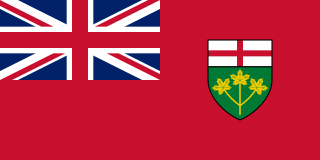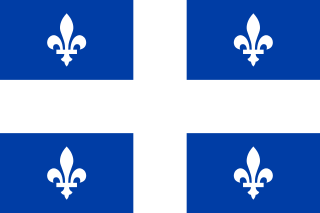Section 33 of the Canadian Charter of Rights and Freedoms is part of the Constitution of Canada. It is commonly known as the notwithstanding clause, or as the override power, and it allows Parliament or provincial legislatures to temporarily override certain portions of the Charter.
The Implied Bill of Rights is a judicial theory in Canadian jurisprudence that recognizes that certain basic principles are underlying the Constitution of Canada. Invoked more often before the Canadian Charter of Rights and Freedoms was enacted, it is nonetheless important when questions of parliamentary supremacy and the override power come into play.

The Manitoba Schools Question(French: La question des écoles du Manitoba) was a political crisis in the Canadian Province of Manitoba that occurred late in the 19th century, involving publicly funded separate schools for Roman Catholics and Protestants. The crisis eventually spread to the national level, becoming one of the key issues in the federal election of 1896 and resulted in the defeat of the Conservative government, which had been in power for most of the previous thirty years. Because of the close linkage at that time between religion and language, the Schools Question raised the deeper question whether French would survive as a language or a culture in Western Canada.
The Constitution Act, 1982 is a part of the Constitution of Canada. The Act was introduced as part of Canada's process of patriating the constitution, introducing several amendments to the British North America Act, 1867, including re-naming it the Constitution Act, 1867.. In addition to patriating the Constitution, the Constitution Act, 1982 enacted the Canadian Charter of Rights and Freedoms; guaranteed rights of the Aboriginal peoples of Canada; provided for future constitutional conferences; and set out the procedures for amending the Constitution in the future.
The Victoria Charter was a set of proposed amendments to the Constitution of Canada in 1971. This document represented a failed attempt on the part of Prime Minister Pierre Trudeau to patriate the Constitution, add rights and freedoms to it and entrench English and French as Canada's official languages; he later succeeded in all these objectives in 1982 with the enactment of the Canada Act 1982.

R v Big M Drug Mart Ltd is a landmark decision by Supreme Court of Canada where the Court struck down the Lord's Day Act for violating section 2 of the Canadian Charter of Rights and Freedoms. This case had many firsts in constitutional law including being the first to interpret section 2.

Reference Re Same-Sex Marriage [2004] 3 S.C.R. 698, 2004 SCC 79, was a reference question to the Supreme Court of Canada regarding the constitutional validity of same-sex marriage in Canada. The ruling was announced December 2004, following arguments made two months prior.
Section 2 of the Canadian Charter of Rights and Freedoms ("Charter") is the section of the Constitution of Canada that lists what the Charter calls "fundamental freedoms" theoretically applying to everyone in Canada, regardless of whether they are a Canadian citizen, or an individual or corporation. These freedoms can be held against actions of all levels of government and are enforceable by the courts. The fundamental freedoms are freedom of expression, freedom of religion, freedom of thought, freedom of belief, freedom of peaceful assembly and freedom of association.

Gosselin v Quebec (AG) [2002] 4 SCR 429, 2002 SCC 84, is the first claim under section 7 of the Canadian Charter of Rights and Freedoms to a right to an adequate level of social assistance. The Supreme Court of Canada rejected the Charter challenge against a Quebec law excluding citizens under age 30 from receiving full social security benefits.

Freedom of religion in Canada is a constitutionally protected right, allowing believers the freedom to assemble and worship without limitation or interference.
Canadian constitutional law is the area of Canadian law relating to the interpretation and application of the Constitution of Canada by the courts. All laws of Canada, both provincial and federal, must conform to the Constitution and any laws inconsistent with the Constitution have no force or effect.

The Supreme Court of Canada was founded in 1875 and has served as the final court of appeal in Canada since 1949. Its history may be divided into three general eras. From its inception in 1875 until 1949, the Court served as an intermediate appellate court subject to appeal to the Judicial Committee of the Privy Council in Britain. Following 1949, the Court gained importance and legitimacy as the court of last resort in Canada, establishing a greater role for the Canadian judiciary. In 1982, the introduction of the Canadian Charter of Rights and Freedoms significantly changed the role of the Court in Canadian society, by providing the Court with greater powers of oversight over Parliament and through formal recognition of civil rights including aboriginal rights and equality rights.

Mahe v Alberta, [1990] 1 S.C.R. 342 is a leading decision of the Supreme Court of Canada. The ruling is notable because the court established that section 23 of the Canadian Charter of Rights and Freedoms requires that parents of the official-language minority in each province have the right either to be represented on the school board, or to have a school board of their own, in order to provide adequate protection for the education rights of their children.

Gosselin v Quebec (AG), 2005 SCC 15, [2005] 1 SCR 238 is a leading case of the Supreme Court of Canada on the constitutional protection of minority language rights under section 23 of the Canadian Charter of Rights and Freedoms. The case was part of a trilogy of minority language rights cases including Solski v Quebec (AG), 2005 SCC 14 and Okwuobi v Lester B Pearson School Board; Casimir v Quebec (AG); Zorrilla v Quebec (AG), 2005 SCC 16.

Adler v Ontario (AG), [1996] 3 S.C.R. 609 is a leading decision of the Supreme Court of Canada on the nature of the provincial education power and whether there was a constitutional obligation to fund private denominational education. The Court found that Ontario's Education Act did not violate sections 2(a) or 15(1) of the Canadian Charter of Rights and Freedoms or section 93 of the Constitution Act, 1867.
Human rights in Canada have come under increasing public attention and legal protection since World War II. Prior to that time, there were few legal protections for human rights. The protections which did exist focussed on specific issues, rather than taking a general approach to human rights. There were notable events in Canada's history which would today be considered violations of human rights.

Alberta v Hutterian Brethren of Wilson Colony, 2009 SCC 37, [2009] 2 SCR 567 is a freedom of religion decision by the Supreme Court of Canada. The court addressed whether a requirement that all licensed drivers be photographed unconstitutionally violated the Hutterites' right to freedom of religion.
Freedom of religion is a constitutionally protected right in Canada, allowing believers the freedom to assemble and worship without limitation or interference, but it was not always so.
The Preamble to the Constitution Act, 1867 provides:











